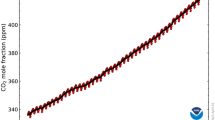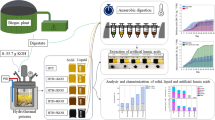Abstract
The aim of this work was to evaluate biomethane production by anaerobic digestion using aqueous phase from Fast Pyrolysis of Douglas Fir Wood as substrate. The effect of biomass acid treatment and condensation temperature on the bio-oil chemical composition and aqueous phase separation with a fractional condensation system coupled to Auger reactor during pyrolysis at 500 °C was reported. As the first condenser temperature was augmented from 40 and 80 °C, the bio-oil yield obtained decreased from 30 to 16 wt% and the aqueous phase yield in the second condenser (kept at 25 °C) increased from 27 till 37 wt%. When the untreated biomass was pyrolyzed, the aqueous phase collected in the second condenser (at the first condenser operated at 80 °C) was anaerobically digested at 100 ppm for 400 h results in 31.3 NmL of CH4/batch. However, the best result was attained after washed biomass with acetic acid (10%) previously to fast pyrolysis, obtaining 86.8 NmL of CH4/batch using just 10 ppm, perhaps due to halved of formed hydroxyacetaldehyde and estimated levoglucosan content increases by more than three times at this condition. Thus, the attained results confirmed the viability of the adopted strategy to improve the anaerobic digestion of the aqueous phase obtained by fractional condensation systems for biomethane production.







Similar content being viewed by others
References
Liaw SS, Zhou S, Wu H, Garcia-Perez M (2012) Effect of pretreatment temperature on the yield and properties of bio-oils obtained from the auger pyrolysis of Douglas fir wood. J Anal Appl Pyrolysis 93:5–62. https://doi.org/10.1016/j.fuel.2012.08.016
Kersten SRA, Garcia-Perez M (2013) Recent developments in fast pyrolysis of ligno-cellulosic materials. Curr Opin Biotechnol 24:414–420. https://doi.org/10.1016/j.copbio.2013.04.003
Yoder J, Galinato S, Granatstein D, Garcia-Pérez M (2011) Economic tradeoff between biochar and bio-oil production via pyrolysis. Biomass Bioenergy 35:1851–1862. https://doi.org/10.1016/j.biombioe.2011.01.026
Meier D, Faix O (1999) State of the art of applied fast pyrolysis of lignocellulosic materials - a review. Bioresour Technol 68:71–77. https://doi.org/10.1016/S0960-8524(98)00086-8
Mohan D, Pittman CU, Steele PH (2006) Pyrolysis of wood/ biomass for bio-oil: a critical review. Energy Fuel 20:848–889. https://doi.org/10.1021/ef0502397
Pandey A, Larroche C (2011) Biofuels - alternative feedstocks and conversion processes, 1st edn. Elsevier, Oxford
Cummer KR, Brown RC (2002) Ancillary equipment for biomass gasification. Biomass Bioenergy 23:113–128. https://doi.org/10.1016/S0961-9534(02)00038-7
Scholze B, Meier D (2001) Characterization of the water-insoluble fraction from pyrolysis oil (pyrolytic lignin). Part I. PY-GC/MS, FTIR, and functional groups. J Anal Appl Pyrolysis 60:41–54. https://doi.org/10.1016/S0165-2370(00)00110-8
Garcìa-Pérez M, Chaala A, Pakdel H, Kretschmer D, Roy C (2007) Vacuum pyrolysis of softwood and hardwood biomass. Comparison between product yields and bio-oil properties. J Anal Appl Pyrolysis 78:104–116. https://doi.org/10.1016/j.jaap.2006.05.003
Oasmaa A, Peacocke C (2010) Properties and fuel use of biomass-derived fast pyrolysis liquids. A guide. Espoo: VTT Technical Research Centre of Finland. VTT publications, No. 731. http://www.vtt.fi/inf/pdf/publications/2010/P731.pdf.
Wang Z, Pecha B, Westerhof RJM, Kersten SRA, Li C-Z, McDonald AG, Garcia-Perez M (2014) Effect of cellulose crystallinity on solid/liquid phase reactions responsible for the formation of carbonaceous residues during pyrolysis. I&EC Research 53:2940–2955. https://doi.org/10.1021/ie4014259
Wu L, Hu X, Mourant D, Wang Y, Kelly C, Garcia-Perez M, He M, Li C-Z (2014) Quantification of strong and weak acidities in bio-oil via non-aqueous potentiometric titration. Fuel 115:652–657. https://doi.org/10.1016/j.fuel.2013.07.092
Yu F, Deng S, Chen P, Liu Y, Wan Y, Olson A, Kittelson D, Ruan R (2007) Physical and chemical properties of bio-oils from microwave pyrolysis of corn stover. In: Mielenz JR, Klasson KT, Adney WS, McMillan JD (eds) Applied biochemistry and Biotecnology. Humana Press, ABAB Symposium
Darmstadt H, Garcia-Perez M, Adnot A, Chaala A, Kretschmer D, Roy C (2004) Corrosion of metals by bio-oil obtained by vacuum pyrolysis of softwood bark residues. An X-ray photoelectron spectroscopy and auger electron spectroscopy study. Energy Environ Sci 18:1291–1301. https://doi.org/10.1021/ef0340920
Lian J, Garcia-Perez M, Coates R, Wu H, Chen S (2012) Yeast fermentation of carboxylic acids obtained from pyrolytic aqueous phases for lipid production. Bioresour Technol 118:177–186. https://doi.org/10.1016/j.biortech.2012.05.010
Westerhof RJM, Kuipers NJM, Kersten SRA, Van Swaaij WPM (2007) Controlling the water content of biomass fast pyrolysis oil. Ind Eng Chem Res 46:9238–9247. https://doi.org/10.1021/ie070684k
Westerhof RJM, Brilman DWF, Garcia-Perez M, Wang Z, Oudenhoven SRG, Van Swaaij WPM, Kersten SRA (2011) Fractional condensation of biomass pyrolysis vapors. Energy Fuel 25:1817–1829. https://doi.org/10.1021/ef2000322
Gooty AT, Li D, Berruti F, Briens C (2014) Kraft-lignin pyrolysis and fractional condensation of its bio-oil vapors. J Anal Appl Pyrolysis 106:33–40. https://doi.org/10.1016/j.jaap.2013.12.006
Liang Y, Zhao X, Chi Z, Rover M, Johnston P, Brown R, Jarboe L, Wen Z (2013) Utilization of acetic acid-rich pyrolytic bio-oil by microalga Chlamydomonas reinhardtii: reducing bio-oil toxicity and enhancing algal toxicity tolerance. Bioresour Technol 133:500–506. https://doi.org/10.1016/j.biortech.2013.01.134
Liaw SS, Frear C, Lei W, Zhang S, Garcia-Perez M (2015) Anaerobic digestion of C1-C4 light oxygenated organic compounds derived from the torrefaction of lignocellulosic materials. Fuel Process Technol 131:150–158. https://doi.org/10.1016/j.fuproc.2014.11.012
Mourant D, Wang Z, He M, Wang XS, Garcia-Perez M, Ling K, Li CZ (2011) Mallee wood fast pyrolysis: effects of alkali and alkaline earth metallic species on the yield and composition of bio-oil. Fuel 90:2915–2922. https://doi.org/10.1016/j.fuel.2011.04.033
Scott DS, Piskorz J, Radlein D (1985) Liquid products from the continuous flash pyrolysis of biomass. Ind Eng Chem Process Des Dev 24:581–588. https://doi.org/10.1021/i200030a011
Lian J, Chen S, Zhou S, Wang Z, O’Fallon J, Li CZ, Garcia-Perez M (2010) Separation, hydrolysis and fermentation of pyrolytic sugars to produce ethanol and lipids. Bioresour Technol 101:9688–9699. https://doi.org/10.1016/j.biortech.2010.07.071
Scott DS, Paterson L, Piskorz J, Radlein D (2001) Pretreatment of poplar wood for fast pyrolysis: rate of cation removal. J Anal Appl Pyrolysis 57:169–176. https://doi.org/10.1016/S0165-2370(00)00108-X
Várhegyi G, Grønli MG, Di Blasi C (2004) Effects of sample origin, extraction, and hot-water washing on the devolatilization kinetics of chestnut wood. Ind Eng Chem Res 43:2356–2367. https://doi.org/10.1021/ie034168f
Oudenhoven SRG, Westerhof RJM, Aldenkamp N, Brilman DWF, Kersten SRA (2013) Demineralization of wood using wood-derived acid: towards a selective pyrolysis process for fuel and chemicals production. J Anal Appl Pyrolysis 103:112–118. https://doi.org/10.1016/j.jaap.2012.10.002
David GF, Perez VH, Justo OR, Garcia-Perez M (2017) Effect of acid additives on sugarcane bagasse pyrolysis: production of high yields of sugars. Bioresour Technol 223:74–83. https://doi.org/10.1016/j.biortech.2016.10.051
ASTM (2007) D1102–84 standard test method for ash in wood, ed. ASTM International, West Conshohocken
ASTM (2007) D1105–96 standard test method for preparation of extractive-free wood, ed. ASTM International, West Conshohocken
ASTM (2007) D1106–96 standard method for acid insoluble lignin in wood, ed. ASTM International, West Conshohocken
ASTM (2007) E1758–01 standard test method for determination of carbohydrates in biomass, ed. ASTM International, West Conshohocken
Ma J, Frear C, Wang ZW, Yu L, Zhao Q, Li X, Chen S (2013) A simple methodology for rate-limiting step determination for anaerobic digestion of complex substrates and effect of microbial community ratio. Bioresour Technol 134:391–395. https://doi.org/10.1016/j.biortech.2013.02.014
Di Blasi C, Branca C, Santoro A, Gonzalez Hernandez E (2001) Pyrolytic behavior and products of some wood varieties. Combust Flame 124:165–177. https://doi.org/10.1016/S0010-2180(00)00191-7
Bailey JE, Ollys DF (1986) Biochemical engineering fundamentals, 2nd edn. McGraw-Hill Inc., New York
Jayakody LN, Hayashi N, Kitagaki H (2011) Identification of glycolaldehyde as the key inhibitor of bioethanol fermentation by yeast and genome-wide analysis of its toxicity. Biotechnol Lett 33:285–292. https://doi.org/10.1007/s10529-010-0437-z
Lian J, Garcia-Perez M, Coates R, Wu H, Chen S (2013) Fermentation of levoglucosan with oleaginous yeasts for lipid production. Bioresour Technol 133:183–189. https://doi.org/10.1016/j.biortech.2013.01.03
Funding
This project was supported by Sun Grant initiative, U.S. Department of Transportation and Washington State University Agricultural Research Center.
Author information
Authors and Affiliations
Corresponding author
Additional information
Publisher’s Note
Springer Nature remains neutral with regard to jurisdictional claims in published maps and institutional affiliations.
Electronic Supplementary Material
ESM 1
(PDF 73 kb)
Rights and permissions
About this article
Cite this article
Liaw, SS., Perez, V.H., Westerhof, R.J. et al. Biomethane Production from Pyrolytic Aqueous Phase: Biomass Acid Washing and Condensation Temperature Effect on the Bio-oil and Aqueous Phase Composition. Bioenerg. Res. 13, 878–886 (2020). https://doi.org/10.1007/s12155-020-10100-3
Published:
Issue Date:
DOI: https://doi.org/10.1007/s12155-020-10100-3




